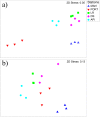Multi-benthic size approach to unveil different environmental conditions in a Mediterranean harbor area (Ancona, Adriatic Sea, Italy)
- PMID: 37397025
- PMCID: PMC10314744
- DOI: 10.7717/peerj.15541
Multi-benthic size approach to unveil different environmental conditions in a Mediterranean harbor area (Ancona, Adriatic Sea, Italy)
Abstract
Harbors are hubs of human activity and are subject to the continuous discharge and release of industrial, agricultural, and municipal waste and contaminants. Benthic organisms are largely known to reflect environmental conditions they live in. Despite meio- and macrofauna interacting within the benthic system, they are ecologically distinct components of the benthos and as such may not necessarily respond to environmental conditions and/or disturbances in the same way. However, in a few field studies the spatial patterns of meio- and macrofauna have been simultaneously compared. In the present study, we assess the response and patterns in the abundance, diversity, and distribution of the two benthic size classes to the different environmental conditions they live in (i.e., sediment concentrations of selected trace metals and polycyclic aromatic hydrocarbons (PAHs); organic matter contents and grain size) characterizing the Ancona Harbor (Adriatic Sea). Meio- and macrofauna provided partially similar types of information depending on the indices used (univariate measures or community structure/species composition) and the different 'response-to-stress'. The community structure (i.e., taxa composition) of both benthic size components clearly showed differences among sampling stations located from inside to outside the harbor, reflecting the marked environmental heterogeneity and disturbance typically characterizing these systems. Notwithstanding, the univariate measures (i.e., meio- and macrofauna total abundance, diversity indices and equitability) didn't show similar spatial patterns. Meiofauna were likely to be more sensitive to the effects of environmental features and contaminants than macrofauna. Overall, trace metals and PAHs affected the community composition of the two benthic components, but only the meiofauna abundance and diversity were related to the environmental variables considered (i.e., quantity and quality of organic matter). Our results pinpoint the importance of studying both meio- and macrofauna communities, which could provide greater insight into the processes affecting the investigated area and reveal different aspects of the benthic ecosystems in response to harbor conditions.
Keywords: Adriatic sea; Benthic size; Contaminants; Harbor; Macrofauna; Mediterranean; Meiofauna.
© 2023 Baldrighi et al.
Conflict of interest statement
Claudio Vasapollo is an Academic Editor for PeerJ.
Figures








References
-
- Anderson MJ. Permutation tests for univariate or multivariate analysis of variance and regression. Canadian Journal of Fisheries and Aquatic Sciences. 2001;58(3):626–639. doi: 10.1139/f01-004. - DOI
-
- Anderson M, Gorley R, Clarke K. PERMANOVA+ for PRIMER: guide to software and statistical methods. Plymouth, UK: PRIMER-e; 2008.
-
- Anderson MJ, Robinson J. Generalized discriminant analysis based on distances. Australian & New Zealand Journal of Statistics. 2003;45(3):301–318. doi: 10.1111/1467-842X.00285. - DOI
-
- Austen MC, Warwick RM, Rosado MC. Meiobenthic and macrobenthic community structure along a putative pollution gradient in southern Portugal. Marine Pollution Bulletin. 1989;20(8):398–405. doi: 10.1016/0025-326X(89)90318-4. - DOI
-
- Austen MC, Widdicombe S. Comparison of the response of meio-and macrobenthos to disturbance and organic enrichment. Journal of Experimental Marine Biology and Ecology. 2006;330(1):96–104. doi: 10.1016/j.jembe.2005.12.019. - DOI
Publication types
MeSH terms
Substances
LinkOut - more resources
Full Text Sources

